The Shambles
The Shambles (officially known as just Shambles[1]) is an old street in York, England, with overhanging timber-framed buildings, some dating back as far as the fourteenth century. It was once known as The Great Flesh Shambles, probably from the Anglo-Saxon Fleshammels (literally 'flesh-shelves'), the word for the shelves that butchers used to display their meat. As recently as 1872 twenty-five butchers' shops were located along the street, but now none remain.
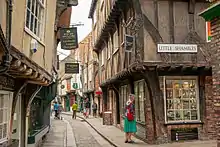 Looking south towards the intersection of Shambles and Little Shambles streets, 2018 | |

Location within York | |
| Former name(s) |
|
|---|---|
| Location | York, United Kingdom |
| Coordinates | 53°57′33.85″N 1°4′48.40″W |
| North end | Newgate, York |
| South end | Pavement, York |
Etymology
"Shambles" is an obsolete term for an open-air slaughterhouse and meat market. Streets of that name were so called from having been the sites on which butchers killed and dressed animals for consumption. (One source suggests that the term derives from "Shammel", an Anglo-Saxon word for shelves that stores used to display their wares while another indicates that by AD 971 "shamble" meant a 'bench for the sale of goods' and by 1305, a 'stall for the sale of meat'. )[2][3]
During that period there were no sanitary facilities or hygiene laws as exist today, and guts, offal, and blood were thrown into a runnel down the middle of the street or open space where the butchering was carried out.
There are streets named "The Shambles" in other UK towns and cities including Bradford on Avon, Chesterfield, Guildford, Swansea, Chippenham, Manchester, Sevenoaks, Whitby, Worcester and Armagh. There is also a Fishamble Street in Dublin.
History
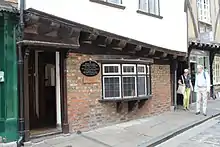
Although not explicitly named in the Domesday Book of 1086, it has been identified through an entry which lists two butchers' stalls near the church of St Crux (ii bancos in macello nr ecclesiam St Crucis) being in the ownership of the Count of Mortain.[4][5] The area was known as Marketshire into the 14th century and included the streets of the Shambles and Pavement. The Shambles itself had several names, by 1240 it was referred to as Haymongergate, and it was called Nedlergate in 1394, both of these are thought to be references to other trades and crafts which took taken place in the street. In addition to these names by 1426 it had become more commonly known as the Great Flesh Shambles, which was eventually shortened to its current name.[4][5] Many of the current buildings are from circa 1350-1475.[2]
Among the structures of the Shambles is a shrine to Saint Margaret Clitherow, who was married to a butcher who owned and lived in a shop in the street. Her home is thought to have been No. 10 Shambles, on the opposite side of the street to the shrine, which has a priest hole fireplace.[6][7][8] As with most buildings in the Shambles these are both listed buildings.[9]
Although the butchers have now vanished, a number of the shops on the street still have meat-hooks hanging outside and, below them, shelves on which meat was displayed. The shops currently include a mix of restaurants and shops as well as a bookshop and a bakery. Five "snickelways" lead off the Shambles.
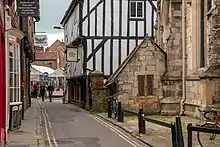
Shambles Market operates daily and is situated between The Shambles and Parliament Street. The market was previously known as Newgate Market after the street on which it is located, but was renamed in 2015.[10]
The Shambles is one of a number of locations, along with streets in Chepstow, Edinburgh, Exeter and London, for which claims have been made that it was the inspiration for Diagon Alley in the Harry Potter franchise.[11] Since 2017 four wizard themed shops have opened in the street.[12] However, the author, J.K. Rowling, has denied this and has stated that she had never been to the Shambles. [13]
Image gallery
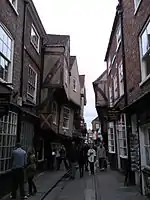 Jettied buildings overhang the street by several feet
Jettied buildings overhang the street by several feet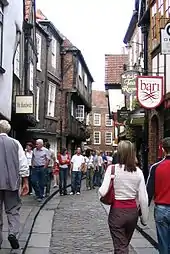 The Shambles is now a popular tourist destination (2005)
The Shambles is now a popular tourist destination (2005)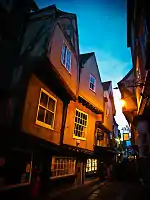 The Shambles by night, 2009
The Shambles by night, 2009
See also
References
- Franks, Alan (12 July 2017). "What a Shambles: a walk around York's ancient walls and alleys". The Guardian. Retrieved 7 November 2017.
- "The Shambles: History of York". www.historyofyork.org.uk. Retrieved 18 June 2018.
- Martin, Gary. "'A complete shambles' - the meaning and origin of this phrase". Phrasefinder. Retrieved 18 June 2018.
- "Shambles". York Civic Trust. Retrieved 6 June 2020.
- "Houses: Shambles-The Stonebow". An Inventory of the Historical Monuments in City of York, Volume 5, Central. London. 1981. pp. 212-220. Retrieved 6 June 2020 – via British History Online.
- "About us". Cuffs & Co. Archived from the original on 4 October 2018. Retrieved 3 October 2018.
- "The Pearl of York". BBC News. 9 October 2008. Retrieved 3 October 2018.
- Historic England. "10 and 11, Shambles (1256676)". National Heritage List for England. Retrieved 29 May 2019.
- "Search results: Shambles York (30 records found)". Historic England. Retrieved 7 June 2020.
- "26 reasons why Shambles Market will change York for good". YorkMix. 22 March 2015. Retrieved 29 May 2019.
- Lovell, Jane (25 March 2019). "Fairytale authenticity: historic city tourism, Harry Potter, medievalism and the magical gaze". Journal of Heritage Tourism. doi:10.1080/1743873X.2019.1588282.
- "I'm sick of all these Harry Potter shops on the Shambles". Nouse. 30 October 2018. Retrieved 29 May 2019.
- "J.K.Rowling statement". Twitter. 21 May 2020. Retrieved 21 May 2020.
Sources
- Pevsner, Nikolaus; revised by Neave, David (1995) [1972]. The Buildings of England Yorkshire: York and the East Riding (2nd ed.). Harmondsworth: Penguin Books. ISBN 978-0-14-071061-8.
External links
| Look up shambles in Wiktionary, the free dictionary. |
| Wikimedia Commons has media related to The Shambles, York. |
- The Shambles Official Website
- The Shambles at Yorkshire Guides
- This is York
- York Shambles tour QuickTime virtual reality image of the Shambles